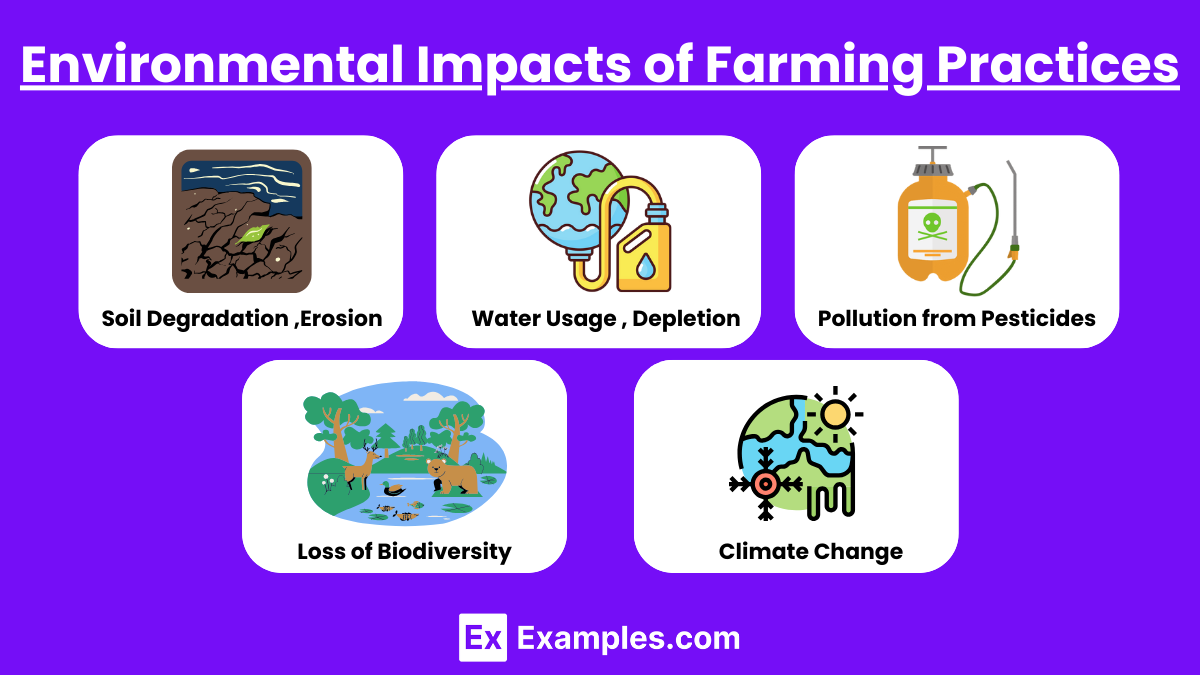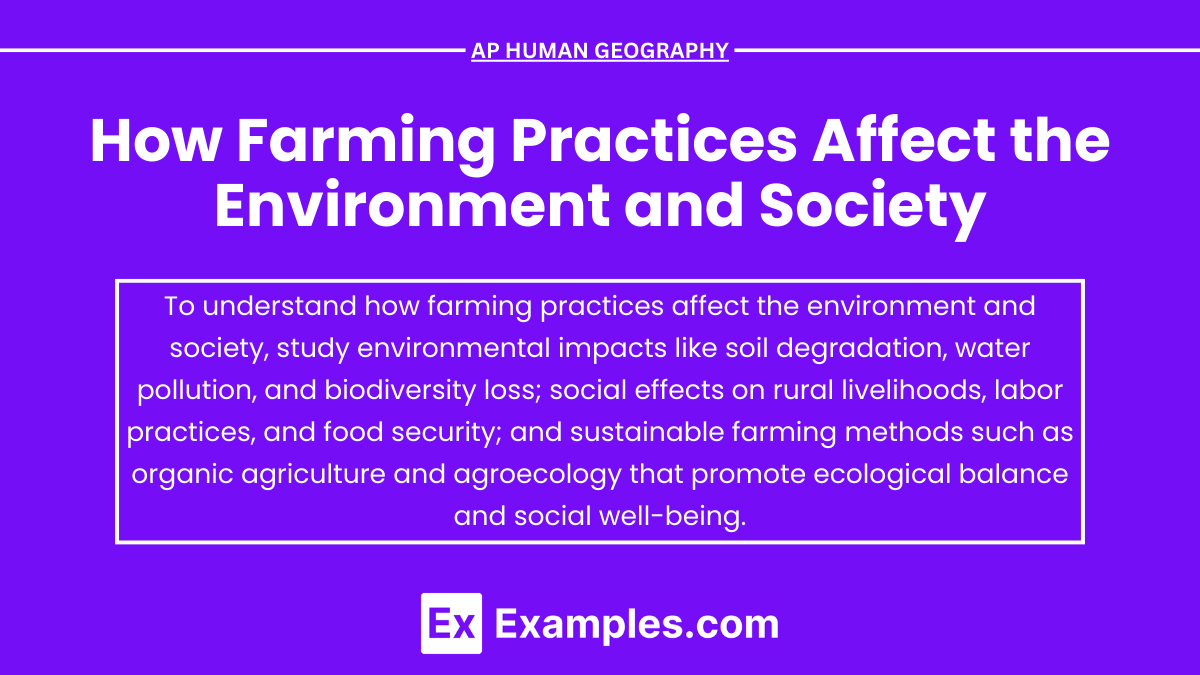Farming practices significantly impact both the environment and society, shaping landscapes and human livelihoods. In AP Human Geography, students explore how practices like monocropping, deforestation, and overuse of chemicals contribute to soil degradation, biodiversity loss, and pollution. Conversely, sustainable methods such as crop rotation and agroforestry help preserve ecosystems. Socially, farming influences food security, rural economies, and land use patterns. Traditional methods can strengthen communities, while industrial farming often leads to rural depopulation and changes in labor dynamics. Understanding these effects is crucial in addressing agricultural sustainability and global food challenges.
Learning Objectives
In studying the topic “How Farming Practices Affect the Environment and Society” for AP Human Geography, you should learn how different agricultural practices impact ecosystems, including soil degradation, water usage, and biodiversity loss. Understand the role of industrial agriculture in deforestation and greenhouse gas emissions, as well as sustainable alternatives like crop rotation and agroforestry. Additionally, explore the societal effects, such as how farming practices influence rural communities, food security, and economic development. Mastering these concepts is crucial for success in AP Human Geography.
Farming, also known as agriculture, is the practice of cultivating soil, growing crops, and raising animals for food, fiber, and other products that sustain human life. It involves a wide range of activities, including planting, harvesting, breeding livestock, and managing land and resources to produce food and materials such as grains, vegetables, fruits, meat, dairy, and wool. Farming can take many forms, from small-scale subsistence farming, which supports a single family or community, to large-scale industrial farming that produces goods for global markets. Farming is fundamental to human civilization and continues to evolve with advancements in technology and sustainable practices.
Environmental Impacts of Farming Practices

- Soil Degradation and Erosion: Over-farming, monoculture (growing the same crop repeatedly), and poor land management practices lead to soil degradation and erosion. This reduces soil fertility, making the land less productive over time.
- Water Usage and Depletion: Agricultural practices often require significant amounts of water for irrigation. In areas dependent on this, such as California’s Central Valley, overuse of water resources can lead to depletion of aquifers, reducing water availability for other purposes.
- Pollution from Pesticides and Fertilizers: The excessive use of chemical pesticides and fertilizers can lead to water contamination. Runoff from farms carries these chemicals into nearby rivers, lakes, and oceans, contributing to eutrophication (excessive nutrients in water bodies), which causes algal blooms that deplete oxygen and harm aquatic life.
- Loss of Biodiversity: Modern farming methods, including monoculture and the use of genetically modified organisms (GMOs), reduce biodiversity. Clearing land for agriculture also leads to habitat destruction, which threatens the survival of various species.
- Climate Change: Agriculture contributes to greenhouse gas emissions through methane from livestock, nitrous oxide from fertilized soils, and carbon dioxide from machinery and land clearing. Deforestation for farmland accelerates climate change by reducing carbon sequestration (the process by which trees absorb carbon dioxide).
Social Impacts of Farming Practices

- Food Security: Intensive farming can increase food production, helping to feed a growing population. However, practices that degrade the environment may lead to reduced long-term food security by lowering the productivity of agricultural land.
- Rural Employment and Livelihoods: Farming provides livelihoods for millions of people, especially in rural areas. However, mechanization and industrial agriculture can reduce the need for labor, leading to unemployment or migration from rural to urban areas.
- Health Concerns: Pesticide use and poor water management can affect human health, particularly for farm workers who are directly exposed to chemicals. Consumers may also face health risks from pesticide residues in food and contaminated water supplies.
- Cultural Impacts: Traditional farming practices are deeply connected to the cultures and identities of many indigenous and local communities. The spread of industrial agriculture can disrupt these practices, leading to a loss of cultural heritage.
- Economic Disparities: Large-scale industrial farming tends to benefit wealthy agribusinesses at the expense of small-scale farmers. This can widen the gap between rich and poor, particularly in developing countries.
Examples
Example 1: Intensive Irrigation and Water Resource Depletion
Agricultural practices that rely heavily on irrigation can significantly deplete local water resources, affecting both the environment and surrounding communities. In regions where water is scarce, such as parts of the Middle East and North Africa, excessive groundwater extraction for farming has led to lowered water tables and dried-up wells. This not only harms aquatic ecosystems but also poses challenges for local populations who depend on these water sources for drinking and sanitation. The overuse of water for irrigation can exacerbate water scarcity, leading to conflicts over water rights and impacting the sustainability of agriculture in the long term.
Example 2: Chemical Fertilizers and Pesticides Leading to Pollution
The widespread use of chemical fertilizers and pesticides in modern agriculture has profound environmental and societal impacts. These substances can contaminate soil and water bodies through runoff, leading to eutrophication of lakes and rivers, which harms aquatic life by depleting oxygen levels. Moreover, the accumulation of chemicals in the food chain poses health risks to humans, including increased rates of certain cancers and developmental issues in children. The reliance on these chemicals also contributes to the decline of beneficial insect populations, such as pollinators like bees, which are crucial for ecosystem health and food production.
Example 3: Deforestation for Agricultural Expansion
The expansion of agricultural land often involves deforestation, which has significant environmental consequences. In regions like the Amazon Basin, vast areas of rainforest are cleared for cattle ranching and soybean cultivation. This leads to habitat loss for countless species, contributing to biodiversity decline. Deforestation also impacts indigenous communities who rely on the forest for their livelihoods and cultural practices. Additionally, the removal of trees reduces carbon sequestration capacity, exacerbating climate change and affecting global weather patterns.
Example 4: Monoculture Farming and Loss of Biodiversity
Monoculture farming, the practice of growing a single crop over a large area, can lead to a reduction in biodiversity and increased vulnerability to pests and diseases. By cultivating only one type of plant, farmers eliminate habitat diversity, which is essential for supporting a range of wildlife species. This lack of diversity can result in the proliferation of pests that specialize in that particular crop, necessitating increased pesticide use. The societal impact includes potential food insecurity if a disease affects the monoculture crop, as seen in historical events like the Irish Potato Famine.
Example 5: The Green Revolution’s Socioeconomic and Environmental Impact
The Green Revolution of the mid-20th century introduced high-yield crop varieties and advanced agricultural techniques, significantly increasing food production in developing countries. While it alleviated hunger for many, it also brought environmental challenges such as soil degradation from intensive farming and increased dependence on chemical inputs. Societally, it widened the gap between wealthy landowners and small-scale farmers, as the latter often could not afford the new technologies and inputs. This led to rural socioeconomic disparities and contributed to urban migration as displaced farmers sought opportunities elsewhere.
Multiple Choice Questions
Question 1
Which of the following farming practices is most associated with soil degradation due to overuse?
A) Crop rotation
B) Terracing
C) Monocropping
D) Agroforestry
Answer: C) Monocropping
Explanation: Monocropping involves the cultivation of a single crop year after year on the same land, which can deplete the soil of essential nutrients. Over time, this practice leads to soil degradation and reduces its fertility, as the same crop repeatedly pulls specific nutrients from the soil. Practices like crop rotation (A) and agroforestry (D) are more sustainable because they restore soil health. Terracing (B) helps reduce soil erosion on steep lands, but monocropping is particularly harmful for long-term soil quality.
Question 2
What is a significant environmental impact of large-scale industrial farming?
A) Increased biodiversity
B) Reduction in greenhouse gas emissions
C) Deforestation and habitat loss
D) Decreased water usage
Answer: C) Deforestation and habitat loss
Explanation: Large-scale industrial farming often requires significant land clearing to make space for crops or livestock, leading to deforestation and habitat loss (C). This reduces biodiversity as animal and plant species lose their habitats. Industrial farming also contributes to increased greenhouse gas emissions (B) and water usage (D), but does not increase biodiversity (A); in fact, it often reduces it by prioritizing monoculture.
Question 3
Which of the following best describes the social impact of shifting cultivation?
A) It promotes urbanization and technological development.
B) It strengthens community bonds through cooperative farming.
C) It causes population displacement due to land scarcity.
D) It encourages agricultural efficiency and mechanization.
Answer: B) It strengthens community bonds through cooperative farming.
Explanation: Shifting cultivation is a traditional farming method that involves rotating land use to allow soil recovery. This practice often relies on strong community cooperation (B) as groups manage land collectively and decide on which areas to farm. It does not promote urbanization or mechanization (A, D), and while land scarcity (C) can be a concern, shifting cultivation is usually practiced in more rural, less densely populated areas where such scarcity is less of a problem compared to intensive farming systems.


